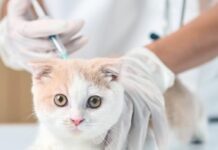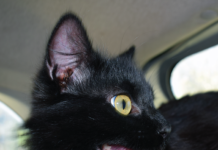Happily, cats are living longer. But longevity also means a greater chance of developing diseases of older age, such as chronic renal failure (CRF).
CRF is the most common form of kidney disease in cats 7 years old or older. It develops slowly, as the kidneys become damaged and gradually work less effectively. All aging cats have reduced kidney function, but not all cats develop renal disease to a life-threatening degree.
More than half the cases of CRF have no identifiable cause, says Stephen DiBartola, DVM, professor of small animal medicine at The Ohio State University College of Veterinary Medicine. The remaining cases are often associated with underlying diseases, including the hereditary polycystic kidney disease (mainly Persian cats), amyloidosis (mainly Abyssinians, Siamese, and Oriental Shorthair cats), renal lymphosarcoma, glomerulonephritis (a disease of the glomerulus, a part of the kidney filtration system), or bacterial infections.
Sleuthing for clues
A physical exam is important to preliminary diagnosis. Veterinarians can palpate a cats kidneys pretty easily, says DiBartola. Kidneys should be about four centimeters in length and pretty smooth. If theyre smaller, lumpy, or hard, thats a signal to do more diagnostic tests such as ultrasound.
Fortunately, anesthesia is rarely required for ultrasound exams or another diagnostic tool, cystocentesis, where urine is withdrawn directly from the cats bladder through a syringe. A urinalysis can show warning signs including elevated protein levels or diluted urine.
A complete blood count (CBC) test can show a high white blood cell count (a finding consistent with inflammation or infection) or reduced red blood cells (anemia). Blood chemistry tests show the creatinine and blood urea nitrogen (BUN) concentrations – both key indicators of renal function – but these tests will not become abnormal until the cats kidneys are seriously impaired, reflecting a loss of 70 to 80 percent of normal function.
Other diagnostic tests for kidney diseases include a biopsy (surgical removal of a tissue sample) or cytology (cells are aspirated through a needle), the latter not usually requiring anesthesia.
Improvement with treatment
Treatment is based on a cats individual problems, but dehydration is common and fluids are especially important. Make sure your cat has plenty of fresh water and ask your veterinarian about giving subcutaneous (under the skin) fluids at home – a less stressful alternative to intravenous fluids in the hospital. Owners can be taught to give injections, DiBartola says.
Cats may improve markedly when an underlying disease or major contributing factor is diagnosed and treated, such as dehydration or infection. DiBartola says patients with mild to moderate kidney disease often feel better after receiving a prescribed diet and a histamine-blocker to reduce stomach acid secretion.
Also, DiBartola says 20 to 30 percent of cats with CRF have low blood potassium concentration and are prescribed supplements, and between one-third and two-thirds of have high blood pressure, which requires medication.
A substantial number of cats with CRF develop anemia, which contributes to their loss of energy, appetite, and stamina. Anemia can be treated with blood transfusions, which are difficult and cumbersome, DiBartola admits, or with a genetically engineered human erythropoietin (EPO) hormone to stimulate red blood cell production. But, sometimes cats produce antibodies that attack the human hormone and may even react to any feline EPO still being produced by the cats own body.
From drugs to diet
Research continues into promising new drug therapies, including a feline recombinant erythropoietin hormone (CatWatch, August 2001) currently under study at Cornell and treatment with the active form of vitamin D (calcitriol), as well as amlodipine or ACE inhibitors such as enalapril, which not only can help regulate blood pressure but also may slow the progression of the kidney disease, DiBartola says. Feline kidney transplants and dialysis are also alternatives, although they are expensive and are offered at only a few veterinary institutions.
Traditionally, CRF is managed primarily with therapeutic diets to restrict protein, phosphorus, and sodium. Reduced dietary sodium can lower blood pressure. Phosphorus binders or lower dietary phosphate is advised because high phosphorus concentrations decrease calcium. Reduced calcium concentration in turn stimulates the release of parathyroid hormone (PTH), which promotes loss of calcium and phosphorus from the bones and increases the excretion of phosphorus by the kidney. High PTH concentration can have toxic effects on the body.
Protein restriction is a bit more controversial, even among veterinarians, DiBartola admits. A lot of protein-breakdown products are floating around in a cats bloodstream when the kidneys no longer work efficiently. These toxins, called uremic toxins, are what makes the cat feel bad – loss of appetite, lack of energy, and other individual effects such as gastrointestinal bleeding. Limiting protein intake reduces protein wastes, and clinical signs may improve. However, cats need protein to maintain muscle structure and energy, so protein malnutrition must be avoided. Further, there is no clear evidence that a restricted-protein diet actually slows the progression of renal disease in cats, DiBartola notes.
Cats with CRF are also taken off diets that make their urine more acidic. Through the years, people have fed cats acidifying diets because of other urinary issues such as feline urological syndrome, he adds. But a cat with chronic kidney disease would actually do worse on an acidifying diet, because one of the jobs of the kidneys is to excrete accumulated acids. With CRF the kidneys are less efficient at doing that. Thus, cats with CRF often have a condition called metabolic acidosis.
Chronic kidney failure is irreversible, but the rate of progression varies widely, DiBartola concludes. Earlier diagnosis, proper nutrition, and managing any contributing diseases and signs can certainly improve the quality and length of an individual cats life.



